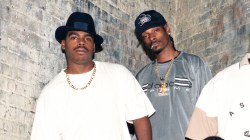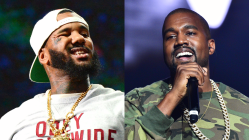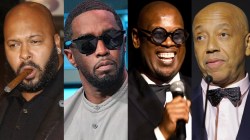10 years ago today, Kendrick Lamar subverted every expectation about him.
The Compton native had broken through into the mainstream with his major label debut good kid, m.A.A.d city, a now seminal moment in Hip Hop history that signaled the arrival of a generational talent with the kind of penmanship usually reserved for Russian novels.
It would have been easy for him to follow the formula of that album and pump out another “Bitch, Don’t Kill My Vibe” or “Swimming Pools,” but instead he did what he has done on each of his subsequent albums: rewrite his own script.
To Pimp a Butterfly is more jazz than it is rap. It has more in common with the deconstructive free jazz of Kamasi Washington (who contributes to several songs on the album) than any of his rap forefathers such as 2Pac or Snoop Dogg (both of whom also feature).
The project is not split into beats and vocals; Lamar’s voice becomes another layer of instrumentation as he uses it as if it was a saxophone in conversation with the sounds around him, rather than just a vortex for thought.
The fact that no album has sounded like To Pimp a Butterfly before or since underscores greatness because this is not the type of music that can be easily replicated. To Pimp a Butterfly stands as a testament to the centuries-long battle of Black survival in the land of the free — through slavery, the Civil War, Jim Crow, mass incarceration, police brutality and economic inequality.
To Pimp a Butterfly is a monument to that cruel history and the eternal hope it takes to survive as a Black person in America.
As the album celebrates its 10th anniversary, HipHopDX explores why To Pimp a Butterfly is one of the most impactful albums of all time.
Music For The Moment
Maybe it was a coincidence or maybe it was Kendrick Lamar understanding America’s milieu in 2015, but To Pimp a Butterfly quickly set its stall out as a State of the Nation album. This was music that soundtracked the uprising after the killings of Michael Brown and Freddie Gray by police officers, with “Alright” going on to become the unofficial anthem of the protest movements against police brutality.
The song’s hook would be shouted at rallies across America in rap’s first truly revolutionary moment since the days of N.W.A’s “Fuck Tha Police” and Public Enemy‘s “Fight the Power.” “Alright” tapped into a feeling of unbearable pressure, decades of frustration and agony in dealing with state-sanctioned violence, and the ultimate perseverance of the human spirit in the face of oppression.
Jazz Rap Goes Mainstream
good kid, m.A.A.d city was an intricately-written, lusciously-sounding album that didn’t necessarily take the kind of huge swings that the Compton superstar would later become known for. Though he didn’t set out to make a jazz album, Kendrick was nudged in that direction by multi-instrumentalist and close collaborator Terrace Martin, who identified chords that Lamar liked as being jazz-influenced.
But this wasn’t jazz rap in the way that Q-Tip incorporated it into A Tribe Called Quest. From “For Free?” to “How Much a Dollar Cost?,” To Pimp a Butterfly is pure, unadulterated free jazz with an added dash of George Clinton-inspired funk.
Coming at a time when the prevailing sound in Hip Hop was Atlanta-heavy with the likes of Future and Migos ruling the radio and clubs, and pop-friendly Drake reaching his commercial peak, To Pimp a Butterfly could not have been a starker reminder that Hip Hop is an intellectual artform — something Kendrick has repeatedly stated in his defense of the genre.
The Ghost of 2Pac
If you paid even the slightest bit of attention to his feud with Drake, Kendrick takes 2Pac very, very seriously. Never was this more apparent that on To Pimp a Butterfly closer “Mortal Man,” which features a mock interview between the two generations of West Coast titans.
The audio of ‘Pac is actually from a previously unheard 1994 sit-down with Swedish music journalist Mats Nileskär, which took place just weeks before he was shot at Quad Studios. In the simulated conversation, Lamar and Shakur discuss pressing topics such as wealth inequality in America and the short life expectancy of Black men.
The conversation is a distillation of both To Pimp a Butterfly’s wider themes of the Black soul in America and the influence that 2Pac has had on Kendrick Lamar ever since he saw him film the “California Love” video as a young boy in Compton.
Conscious is King
By the mid-2010s, conscious rap had long gone out of fashion. The biggest artists in the game were Drake, Future and Nicki Minaj, while Fetty Wap and Rae Sremmurd were the new kids on the block. They had catchy hits, sure, but it was not music for the soul or the brain. Kendrick’s biggest skill has always been making novelistic songs that can be palatable to a wider audience, much like his hero 2Pac.
“The Blacker The Berry” is still arguably the most startling song in Kendrick’s now vast catalog. With a dancehall-flavored hook courtest of Assassin, Dot focuses much of the song on Black stereotypes, revolutionary spirit and the prevalence of gang violence in Black communities. It is the kind of art that every song should aspire to be: challenging, emotive, intellectually stimulating and still sound amazing.
The History of Black America
“Four hundred years ago, as slaves, we prayed and sang joyful songs to stay level-headed with what was going on,” Kendrick said to NPR in a rare interview about the album. He understood that the starting point for To Pimp a Butterfly was the arrival of Black people in America, mostly on slave ships. His seminal 2015 album subsequently follows the lineage of Black music down the generations to present day Hip Hop.
From the opening track, “Wesley’s Theory,” which makes use of both funk legend George Clinton and Boris Gardner’s declarative and hopeful “Every N-gger is a Star” to the closing tribute to 2Pac, To Pimp a Butterfly is a journey through Black music.
Elsewhere on the album, there is the use of Michael Jackson, a sample of The Isley Brothers, an interpolation of James Brown and even an excerpt from Fela Kuti’s “I No Get Eye for Back,” covering everything from ’70s funk to ’80s pop.
To Pimp a Butterfly is a lesson in how people and culture move from one place to the next — and in doing so, Kendrick Lamar solidified himself as the voice of his generation, a title he still carries to this day.






![50 Cent Shares Unseen Diddy Footage From Netflix Documentary: "[It] Shows You His Character"](https://hiphopdx.com/wp-content/uploads/2025/12/50-cent-diddy-documentary-trailer-unseen-footage.jpg?w=250)


Tpab didn’t define a generation of hiphop or culture..m
August Alsina Testimony was better and needs more love and This Thing Called Life too
Musics so shit now that tpab is considered generational lol ..mid IQ music for basic people
Most overrated album ever….
one of the best albums ever written
Don’t bother with kendrick fans. They’re pretty much carbon copies of eminem fans. Both idolize these men and see them as God’s gift to humans lol.
Fax – Drake dick rider alert
This is the album white people shit on because it wasn’t made for them at all. Kendrick shits on whites for the duration of the album and bigs up blacks while they’re forced to nod their head to civil rights era soul samples.
@Not Like Us White people realize it’s a diss but they know it hits a nerve on you when they talk about it rap along with it etc. You’re easy.
Yet myself, and others around me don’t like it and never did… and we’re pretty much all black. You’re trying to find something that isn’t there. It’s not a bad album at all, in fact, I think its a very solid album. But generational? No. That was GKMC or even Section .80 more so than TPAB. TPAB wasn’t for hiphop fans. It’s for funk fans. While it’s true there were lots of racial themes throughout the album, such as King Kunta or Complextions (both tracks I enjoyed), overall it isn’t as special as K Dot fans portray it to he, hence why you never hear it played today.
You’re white
Incredible album up there with the best. This article is well written and u particularly like the part where the album hasn’t been replicated, this shows the genius of the album. Additionally, I don’t believe many, if any, artists would tackle the subject matter in case it hurt thier career. In fact what Kendrick took a lot of courage and self belief.
No shade. Didn’t like the album too much. It didn’t age well. But wish him the best still. He’s a great artist, just overrated .
best album of all time objectively
best album of all time objectively
VERY objectively. this wasn’t even the best album that year. DS2 by Future was more “generation defining” than TPAB was.
best album of all time objectively.
An overrated album by an overrated artist.
Still trying to push the f6ggot rap huh? Cocksuckers
Great Greg -still sucking cocks
Put a bullet in your weak f8ggot dome. Fuck benderick lamer fuck the f8ggot reject blog. Cocksuckers die 💀
Great Greg – still saying gay things
Lol and now he’s making songs with a fake gang banger, devil worshipping, woman beater, deadbeat dad who knocked up white colonizer Iggy Azalea.
this album for sure was not generation defining.
The Greatest & Most important album of all time. Kendrick has surpassed The Beatles as the greatest artist of all time